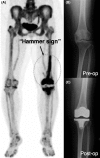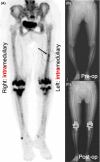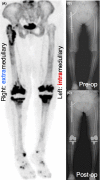NaF PET assessment of bone metabolic changes around the femoral canal by intramedullary femoral alignment technique in total knee arthroplasty
- PMID: 31183095
- PMCID: PMC6553561
- DOI: 10.1002/ccr3.2187
NaF PET assessment of bone metabolic changes around the femoral canal by intramedullary femoral alignment technique in total knee arthroplasty
Abstract
We used the NaF PET scan to assess osteometabolic changes around the distal half of the femoral canal by intramedullary (IM) drill for femoral IM guiding rod insertion in total knee arthroplasty. Gentle IM rod insertion and focused attention can minimize surgical stress-induced biological reaction of the femoral IM canal.
Keywords: NaF; PET; extramedullary; intramedullary; total knee arthroplasty.
Conflict of interest statement
The authors have declared that no conflict of interest exists.
Figures



References
-
- Ritter MA, Keating EM, Sueyoshi T, Davis KE, Barrington JW, Emerson RH. Twenty‐five‐years and greater, results after nonmodular cemented total knee arthroplasty. J Arthroplasty. 2016;31:2199‐2202. - PubMed
-
- Kanetaka M, Kaneko S, Wagatsuma K, et al. Natural postoperative bone metabolic changes after total knee arthroplasty determined by positron emission tomography scans. Open J Orthop. 2018;8:443‐457.
-
- Nam D, Cody EA, Nguyen JT, Figgie MP, Mayman DJ. Extramedullary guides versus portable, accelerometer‐based navigation for tibial alignment in total knee arthroplasty: a randomized, controlled trial: winner of the 2013 HAP PAUL award. J Arthroplasty. 2014;29:288‐294. - PubMed
-
- Laskin RS. Minimally invasive total knee arthroplasty: the results justify its use. Clin Orthop Relat Res. 2005;440:54‐59. - PubMed
-
- Liu HC, Kuo FC, Huang CC, Wang JW. Mini‐midvastus total knee arthroplasty in patients with severe varus deformity. Orthopedics. 2015;38:e112‐117. - PubMed
Publication types
LinkOut - more resources
Full Text Sources

